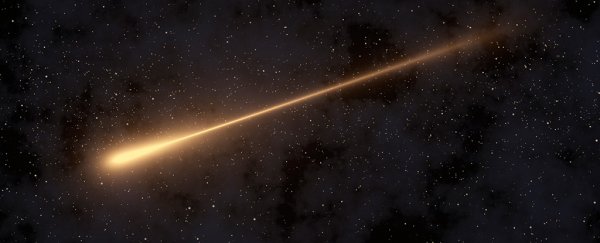According to new calculations, we may have a little less time to prepare for a star on course to kiss the edges of our Solar System.
Yep. Dwarf star Gliese 710, which we've known about for some time, could now arrive in 1.29 million years, instead of the previously calculated 1.36 million years.
Gliese 710 is what is classified as a rogue star - one that has gone roaming across the galaxy, free of the gravitational chains that normally hold stars in position.
At a speed of 51,499 kilometres per hour (32,000 miles per hour), it's not quite fast enough to be considered a runaway star, but it's still travelling at a hefty clip.
We've known Gliese 710 was on a trajectory that would bring it close to the Solar System since at least 1996, but it wasn't until late 2016 that we had a decent ballpark on the timeframe.
Based on the first release of data from the ESA's Gaia mission, astronomers Filip Berski and Piotr A. Dybczyński calculated that Gliese 710, then around 63.8 light-years (19.6 parsecs) away in the northern constellation of Serpens, was due to arrive in approximately 1.35 million years.
Now astronomers Raul de la Fuente Marcos and Carlos de la Fuente Marcos from the University of Madrid have checked that calculation based on the second, more accurate release of Gaia data from earlier this year, and confirmed it.
With a major difference: using the new data, the arrival time has been pushed forward by a few tens of thousands of years - and could brush closer than previously expected to the Solar System.
"Our results confirm, within errors, those in Berski & Dybczyński (2016), but suggest a closer, both in terms of distance and time, flyby of Gliese 710 to the solar system," the researchers wrote in a new paper.
It's important to note the paper has been released prior to final peer review. But with that proviso in mind, the fact this is a follow up analysis that confirms earlier data is an interesting next phase in the story.
Berski and Dybczyński found that Gliese 710 would enter the Oort cloud to pass by the Sun a distance of about 13,365 astronomical units (each astronomical unit is the distance between Earth and the Sun).
According to the new research, it will graze us at a distance of 4,303 AU. That's not actually very close - it's over 100 times the distance to Pluto, which orbits the Sun at an average of 39.5 AU. But it still has the potential to disrupt the Solar System.
If humans are still around on Earth at that point, we don't have to worry about any disruptions to our orbit. Gliese 710, which is only about 60 percent of the Sun's mass, may only have that effect on the outer Solar System, if at all, and shouldn't affect anything within 40 AU.
What it could do, however, is behave like the proverbial fox among the Oort cloud's chickens. The Oort cloud is a theoretical sphere of icy planetesimals that is thought to surround the solar system at distances between 200,000 and 50,000 AU.
If Gliese 710 enters the Oort cloud, it could send these planetesimals careening through the solar system - resulting in showers of comets.
But the Solar System has weathered close encounters with other stars before, such as Gliese 208, which passed by at a distance of around 5 light-years 500,000 years ago; and, more recently at 70,000 years ago, Scholz's star, which passed through the Oort cloud.
Which, coincidentally, is when humanity almost became extinct for completely unrelated reasons. Probably.
You can read the new paper on the preprint website arXiv.
